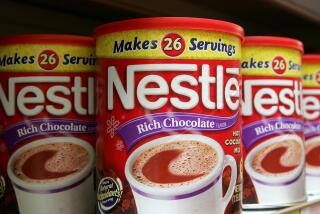America’s Love Affair With Chocolate Turns Bittersweet
- Share via
WASHINGTON — The odyssey of the cocoa bean from fermenting fruit in the steamy African lowland to delectable chocolate bonbon in a Park Avenue boudoir is filled with romance--and a lot of hard economics.
After flying high in the inflationary ‘70s, the price of cocoa has gone into a long, irregular slide that, while sweet for candy manufacturers and consumers, has meant hardship to the Third World countries that produce cocoa.
Consequently, an international organization of producers and consumers is preparing to try to prop up the price.
The supply of cocoa--the raw material for the beverage, chocolate confections and coatings, cocoa-butter skin products and animal feed--has exceeded demand for the past three years.
The U.S. Department of Agriculture’s foreign agricultural service projects the harvest for the year beginning in September, 1986, will exceed 1.9 million metric tons.
Consumption is expected to reach about 1.8 million tons, so unless bad weather spoils crops, there will be a surplus of about 100,000 tons. That will bring stocks at the end of the season to about 700,000 metric tons, according to Gill & Duffus Group, one of the leading cocoa trading houses.
Meanwhile the price of cocoa, which peaked at $1.90 per pound on the New York spot market in 1977, declined in the first quarter of this year to less than 90 cents a pound.
And purchases by the United States, the world’s largest importer with 205,000 metric tons last year, declined by 12% in 1986 as traders waited for the price to fall further.
Two centuries after the first domestic chocolate factory was established near Boston, America’s love affair with chocolate may be turning bittersweet. Changing tastes, fear of obesity and concerns about fat-saturated foods, dental cavities, acne, caffeine and the like have conspired to dampen consumption.
Domestic chocolate-candy consumption rose only about 0.2% in 1986, according to the Commerce Department’s U.S. Industrial Outlook. Americans ate an average of 9.7 pounds of chocolate candy apiece last year, while per-capita consumption in 1986 of other types of candy rose 1.2% to 8.4 pounds. Switzerland, with its worldwide reputation for fine chocolate, has per capita cocoa consumption double that of the United States.
Value Rises
The value of chocolate candy shipments rose last year by 25%, largely on the basis of exports to Japan that zoomed by 134% to almost $20 million. The increase occurred despite Japan’s 20% tariff on imported chocolate, compared with a 7% U.S. tariff.
The outlook for the confectionery products industry is “not especially rosy,” according to the Commerce Department. And the demand for high-priced imported chocolates selling for $25 or more a pound has “probably peaked,” government economists concluded.
Due to the oversupply and decreased demand, the 35 producing and consuming nations of the International Cocoa Organization (ICCO), are preparing to revive price-support arrangements inactive since 1982.
After months of debate, ICCO members achieved a new cocoa agreement in London last January and agreed on trigger price levels in late March. When the benchmark price of cocoa dips below about $2,064 per metric ton, or 94 cents per pound, the “buffer-stock manager,” currently a German national named Jurgen Plambeck, must buy stocks of beans with funds from a $250-million kitty, created through an international levy on cocoa of $45 per ton. The stocks will be held in warehouses until the world price rises.
Whether this approach will work is highly questionable, U.S. officials said. They point to other cartels that have been unsuccessful against market forces.
Has No Quotas
Two years ago the International Tin Council, which had a similar price support mechanism, collapsed when there wasn’t enough money available to buy excess stocks.
ICCO has no quotas on how much must be purchased from each country--but only 15% can come from non-member countries. That could affect one of the fastest-growing producers, Malaysia, which does not belong to ICCO.
The largest producer, Ivory Coast--with a projected harvest of 525,000 metric tons this year--recently joined the cartel.
Cocoa amounts to about 40% of that country’s foreign exchange, but only 5% of the value of exports from Brazil, the second-largest producer with 415,000 tons. Ghana ranks third with 225,000 tons, amounting to 75% of its foreign exchange.
On the consuming side, the Common Market countries and the Soviet Union are members, but the United States does not belong to ICCO because, government officials said, the Administration is philosophically opposed to barriers to free trade.
The officials also said, but not for the record, that membership would serve no purpose because the cocoa cartel is not strong enough to stabilize prices.
Richard T. O’Connell, president of the Chocolate Manufacturers Assn., cites previous unsuccessful attempts to intervene. In 1981-82, the buffer stock manager purchased 100,000 metric tons of cocoa, but prices dropped anyway.
Wall Street commodity analysts also display skepticism about the effectiveness of ICCO efforts, although there appears to be a consensus that intervention might bolster prices temporarily.
Since the support levels were set in late March, the price of cocoa for May delivery on the New York Coffee, Sugar and Cocoa Exchange has increased by about $100 a ton to $1,995 a ton, or 90 cents a pound. But there is also wide agreement that the long-term outlook remains bearish.
For chocoholics, there seems to be little danger that the cost of their favorite sweet will soar as the result of ICCO’s actions. The price of cocoa accounts for about 60 cents of the $2-per-pound current wholesale price of chocolate. The rest represents the cost of sugar, milk, flavoring, other ingredients and manufacturing costs.
Although cocoa as a beverage is said to have been brought back to Spain from Latin America by 16th-Century explorers, it was not until 1876 that the familiar milk chocolate candy was invented in Switzerland.
As chocolate manufacturers like to say, “There are literally tons and tons of equipment that the beans must pass through on their way to becoming chocolate.” The process begins with the cacao tree, a native of Central and South America. (It was transplanted later to Africa and Asia.)
The cream-colored seed is embedded in the pulp of highly colored pods the size of elongated cantaloupes. There are 20 to 40 pods per tree and 25 to 50 seeds per pod; 400 beans are needed for a pound of chocolate.
The pods are harvested from September to March, their tough hulls split open with a machete and the fruit left in the sun to ferment for three to 10 days. The beans are then dried. This process turns the bean brown and produces the chocolate flavor.
There are different grades of cacao with different flavors. While Ghana cocoa is the standard for basic chocolate flavor, the best comes from Trinidad and Ecuador, according to John Rita, who mixes flavors for Hershey.
The beans are shipped to Europe and elsewhere for roasting, blending and grinding. In the grinding process, the cocoa meat, or “nibs,” breaks down into chocolate liquor and liquid cocoa butter.
The liquor can be molded into bitter baking chocolate or, after more fat is removed, pressed into a cake that is pulverized into breakfast cocoa.
Chocolate to be eaten as candy requires the addition of cocoa butter, sugar, flavoring such as vanilla and often milk solids. The mixture is then refined and kneaded into a paste.
The different temperatures and the degree of agitation and aeration used produce the various flavors of candy bars and other chocolates. Each chocolatier’s recipe is as secret as that of the perfume blender.
Unlike Europeans, Americans prefer milk chocolate over dark chocolate by about 60% to 40%, said Rita.
U.S. law requires chocolate to contain a minimum of 10% chocolate liquor. The gourmet fad “white chocolate”--Neiman-Marcus recently introduced a white-chocolate-flavored toothpaste--is legally a misnomer, because it contains cocoa butter, sugar and milk, but no chocolate liquor.
More to Read
Eat your way across L.A.
Get our weekly Tasting Notes newsletter for reviews, news and more.
You may occasionally receive promotional content from the Los Angeles Times.






